Bear
Lodge, Wyoming, http://www.nps.gov/deto/
also known as Devil's Tower is an iconic image of the American
west. It is easily
recognizable in an old western, when carved in mashed potatoes, or
when serving as a landing strip for alien visitors in Close
Encounters of the Third Kind. President
Theodore Roosevelt established Devils Tower National Monument on
September 24, 1906. The spectacular rock formation is located west
of the Black Hills
near Hulett and Sundance in Crook County, northeastern Wyoming,
above the Belle Fourche River. It
is a massive intrusive igneous monolith visible for miles.
The tower rises 867 feet from its base to the summit and
1,267 feet above the Belle Fourche River flowing through
the eastern edge of the monument.
The tower itself is 1 mile in girth at its base.
The summit , 5,112 feet (1,558 m) above sea level. is
a slightly domed plateau
200 feet by 400 feet in size, about the same as a football field
and .

It
was given the name Devil's Tower by an expedition mapping the
region in 1875. Led by Col.Richard Irving Dodge, it is believed
his interpreter misinterpreted the name to mean Bad God's Tower,
later shortened to Devils Tower.
Native
Americans have different names for the tower.
George L. San Miguel, August
1994, http://www.nps.gov/archive/deto/place.htm
writes: "A review of the ethnographic literature demonstrates
that Devils Tower was a sacred area for several Plains Tribes, and
that it has been encoded as an important landmark in tribal
narratives." According
to the National Park Service, over twenty tribes have potential
cultural affiliation with Devils Tower National Monument.
Tribes including the Arapaho, Crow, Cheyenne, Kiowa,
Lakota, and Shoshone had cultural and geographical ties to the
monolith before European and early American immigrants reached
Wyoming. Their names for the monolith include: Aloft on a Rock
(Kiowa), Bear's House (Cheyenne, Crow), Bear's Lair (Cheyenne,
Crow), Bear's Lodge (Cheyenne, Lakota), Bear's Lodge Butte
(Lakota), Bear's Tipi (Arapaho, Cheyenne), Tree Rock (Kiowa), and
Grizzly Bear Lodge (Lakota).
I would like to see the name of the National Monument
changed to Bear Lodge
in respect of the Native American nomenclature.
Geology
The
surrounding landscape is formed of rocks derived from deposits
laid down in a shallow sea during the Triassic time, 225 to 195
million years ago. This dark red sandstone and maroon siltstone,
interbedded with shale, can be seen along the Belle Fourche River.
The red color is from oxidation of iron minerals within the
bedrock. It is
interesting that there are several geologic periods, the Triassic
being one of them, characterized
by red rocks, likely a reflection of environmental conditions at
those times. The
Triassic is the earliest period
of the three in the Mesozoic Era - the age of the dinosaurs.
This red rock sequence is known as the
Spearfish formation. Above the Spearfish formation is a thin band
of white gypsum, called the Gypsum Spring formation. This layer of
gypsum was deposited during the Jurassic time, 195 to 136 million
years ago.

About
65 million years ago, during the Tertiary period, the Rocky
Mountains and the Black Hills were uplifted. Molten magma rose
through the crust, intruding into the already existing sedimentary
rock layers. In 1907,
scientists Darton and O'Hara decided that Devils Tower must be an
eroded remnant of a laccolith. A laccolith is a large mass of
igneous rock which is intruded through sedimentary rock beds but
does not actually reach the surface, producing a rounded bulge in
the sedimentary layers above.
This is by far
the best explanation of the origin of the tower.
Others have suggested it is a volcanic plug formed in the
neck of a volcano, but there is no evidence anywhere of lava or
ash flows that would be associated with such a volcano.
The rock cooled close to the surface of the earth.
This is known because the grain size of the rock making up
the monument is very fine. The
faster an igneous rock cools, the finer the mineral grain making
up the rock. The rock
itself is a phonolite porphyry, a light to dark-gray or
greenish-gray igneous rock with conspicuous crystals of white
feldspar. A porphyry
is a rock with larger crystal embedded in a fine grain matrix.
It indicates the history of cooling of the rock.
First it cooled slowly for a time forming larger crystal,
the feldspar, within the liquid magma. Then the magma was pushed
upward toward the surface where the rest of the liquid cooled too
rapidly to form large crystals.
This stage formed the gray to greenish gray fine grained
matrix of the rock. As the lava cooled, hexagonal (and sometimes
4-, 5-, and 7-sided) columns formed. As
the columns continued to cool, vertical cracks developed as the
columns shrank horizontally in volume.
This is a typical characteristic of surface and shallow
intruded basalts. Since
the intrusion there have been two separate erosion events that
removed the surrounding sedimentary rock and exposed the igneous
monolith. The first
exposed the top portion of the tower and exposed it to erosion.
Then a later episode of erosion, exposed the rest of the
tower as we see it today. Looking
at the monolith, it can be seen that the top section has been more
severely eroded than the lower portions.
Bear
Lodge Report
I
have been to Bear Lodge three times.
Some people are of the mentality that you stop the car,
snap a photo, and you have seen the "sight."
I have found that at each visit there is something more to
see. At each trip you
are at a different point in your life, with your perspective
colored by experiences since your last visit.
There are things to see that you might have missed the
first time, or the second, or the twenty-third.
My first trip was when I was in high school and had just
completed a summer college field camp at the University of
Wisconsin- Superior.
My parents picked me up there and we went on a
whirlwind trip of many western parks, including Devil's Tower. My
second was during my college career.
I went to a Summer Geologic Field Camp partially set in the
Black Hills as part of the requirement to complete my Bachelor's
degree. My head as
this time was filled with geological processes.
My last trip was in 2005.
I was already involved with the Eastern Native Tree
Society, and deeply
involved with photography and video.
On this trip I saw more of the trees and vegetation that
were just a background to the tower itself on my previous trips.
I rolled into Wyoming anticipating the first view of the
tower off in the distance. I
had just left the Black Hills, in the midst of the Sturgis
Motorcycle rally that morning.
I had slept in my tiny car overnight at a
camping place in the Black Hills National forest.
Massive lightning storms had flashed across the horizon all
night with gusts of wind. My
tent had been leaking , and I didn't want to set up in the
impending storm. The
motels and hotels for a hundred miles around were all full.
The one room I found, it seemed the price more approached
buying the property, than sleeping for the night.

At
last the thumb of the tower could be seen of fin the distance,
ever growing larger as I approached.
The sun was to the west by now and the face was in shadow,
but still it called for photo stops along the road.
At last I arrived at the park.
There isn't much development
near the one entrance to the park.
There are a few gift shops, a restaurant, and gas station.
I showed my Park Pass at the gate and made my way to the
campground. The
campground is set up on a flood plain meander of the Belle Fouche
River. There are a
number of cottonwoods in the campground, but they do not appear to
be very old, and most are in poor shape.
There was talk of removing them as they might present a
hazard to campers from falling limbs.
I think this would be a mistake.
But this is only one of many that have been made in the
past by managers at the park and surrounding areas.

In
this riparian corridor many old, dead cottonwoods line the Belle
Fourche River near the entrance, and no young cottonwoods or
willows are replacing older trees. Other native vegetation along
the river corridor (called the riparian zone), is being replaced
by non-native species. This
is a direct result of past river management.
First the river channel in this area was straightened to
reduce flooding. Then
a dam was built upstream of this location, also for flood control.
Species like the cottonwood and other native riparian
vegetation require the repeated flooding of the flood plain to
distribute the seeds for young vegetations and to limit the growth
of flood intolerant species.
To their credit , the NPS has un-straigtened the river,
rerouting it to flow along its old course, but nothing has been
done about the dam that still prevents natural flood cycles.
They are planting seedling of cottonwood and other species
in the floodplain to try and reestablish the original species
populations.
After
spraying my newly dried tent with waterproofing, I headed out to
see the tower itself. A
side road to the left just before reaching the tower parking lot
itself leads to an open field with a spectacular view of the
southwestern (?) face of the tower.
I snapped few shots, and headed tom the base of the tower
itself. The tower
looks interesting from a distance, but close up there is a feeling
of awe or weight as the massive bock of rock with near vertical
sides towers above you. The
parking lot is full. The monument
receives about 400,000 visitors a year, with around 4,000 people
climbing the tower. That
is another subject of controversy - the climbing.
The most recent management plan was developed by the park
service, interested groups, and representatives of various Native
American Nations concerning various
aspects of managing the tourist population and the climbing aspect
in particular.
The
tower is the site of many sacred legends of many tribes in the
region, and today still serves as a site for various religious and
cultural practices.
Climbing the tower is at odds with some of
these native cultural elements.
As a compromise, the Park Service has implemented a
voluntary no climb period. The
NPS website http://www.nps.gov/archive/deto/climbing.htm
reads: "American
Indians have regarded the Tower as a sacred site long before
climbers found their way to the area. Recently, American Indian
people have expressed concerns over recreational climbing at
Devils Tower. Some perceive climbing on the Tower as a desecration
to their sacred site. It appears to many American Indians that
climbers and hikers do not respect their culture by the very act
of climbing on or near the Tower.
A key element of the Climbing Management Plan is the June
Voluntary Climbing Closure. The National Park Service has decided
to advocate this closure in order to promote understanding and
encourage respect for the culture of American Indian tribes who
are closely affiliated with the Tower as a sacred site. June is a
culturally significant time when many (not all) ceremonies
traditionally occur. Although voluntary, this closure has been
very successful - resulting in an 80% reduction in the number of
climbers during June. During
June, the NPS asks climbers to voluntarily refrain from climbing
on the Tower and hikers to voluntarily refrain from scrambling
within the inside of the Tower Trail Loop. Please strongly
consider the closure when planning a climbing trip to Devils
Tower. Alternative climbing areas are located within 100 miles of
Devils Tower National Monument. "
I would not oppose a mandatory closure of the tower to
climbing for the month, instead of a voluntary closure.
It is clear however, especially given the events of the
recent past in Arches national Park, Utah, that the park needs a
formal management plan for climbing the tower.
( A rock climber climbed Delicate Arch, not specifically
forbidden by the regulations at Arches, and it appear there were
tope marks left in the soft rock of this iconic arch.)
More about the sacred nature of the tower and the history
of climbing of the rock.
These
thoughts were playing on my mind as I walked to the base of the
tower. A must hike
for everyone who visits the monument is the
Tower Trail. "Tower
Trail - 1.3 miles (2 km) The
Tower Trail is the easiest and most popular trail in the monument.
You will enjoy close up views of the Tower, while walking through
strikingly different environments. Expect close views of the
boulder field, ponderosa pine forest, and the fringe of meadow
habitats. Interpretive
exhibits along the way point out such natural processes as the
formation of the Tower, erosion of the landscape, local wildlife,
and the flora of the base. The Tower Trail is paved with benches
provided at various points. The steepest part of the trail is the
very beginning but soon levels into a rolling trail. Plan to take
45 minutes to 1 hour to complete this loop trail."
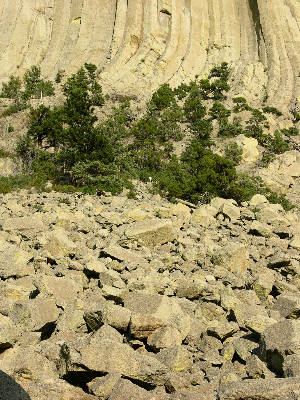
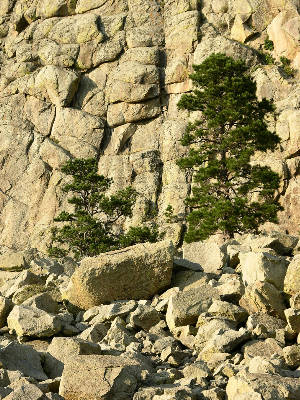
This
trail loops tightly around the base of the tower, just outside the
talus pile of columnar columns fallen from the tower.
Many of these are thicker than a person is tall.
A few paths lead up into the jumbled pile and allows you to
explore among the fallen pieces.



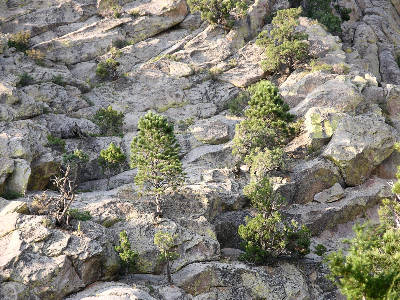
Again
the overwhelming feeling this close to the base of the tower is
one of mass and weight towering above you.
As you walk around the tower, the paved path wends its way
through the ponderosa pine forest.
Gaps in the trees reveal framed vistas of the tower beyond.
One
thing that has always fascinated me, mo so even than big trees,
are the trees clinging to cracks or small ledges in cliffs and
rocks. Here there are
a plethora of these pioneer warriors clinging to life on the sides
of the tower. Every
place you look are more ponderosa pine specimens.

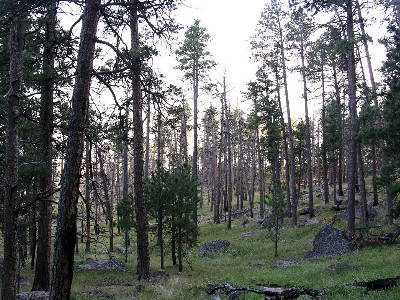
Some
are straight and tall, others are small and gnarled.
It is a photographers dream, if that is your chosen
subject.
The
ponderosa pine is another example of bad decisions made in the
past. The natural
vegetation regime was maintained by a cycle of small fires every
fifteen to twenty years. However
the ranchers in the area, and the early Forest and Park Service.
The fires were all suppressed and interrupted the natural
balance in the system. As
a result there was a drastic drop in species diversity.
Those species requiring open areas and sunlight were lost,
or limited. Instead
of a diverse natural system, there now exists a system with one
basic species - Ponderosa pine. Plants requiring sunlight and open
space are seldom seen. If fires were to occur naturally, the
overstory canopy would remain open, allowing plants that require
sunlight to thrive. This
also has allowed a large amount of pine needles, sticks, and other
incendiary materials to accumulate.
I believe they are removing some of this material now, as
the accumulation has reached a point that if it caught on fire, it
would also kill the ponderosa pines as well as any other species.
The NPS website reports, "Many
non-native plant species have made their way into Devils Tower
National Monument, competing with native plants, and, in many
cases, out-competing them. Biologists have identified at least 56
exotic (non-native) plant species in Devils Tower. Three of these
- Leafy Spurge, Houndstongue, and non-native species of Thistles -
are being actively managed."
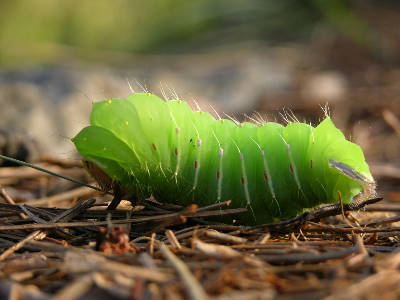

Don't forget
to watch for the small stuff as you visit the grandest.
After
shooting many photos, I returned to the field where I had a good
view of the western face of the monument.
I waited there and shot photos as the sun slowly set behind
me.

There
are evening programs given many nights at various parks and
monuments. I always
attend these when I have a chance.
They provide an opportunity to hear what the local experts
have to say about the area, and to learn about things to see and
do that you may have missed.
There
are two other trails worth checking out in the monument:
"Joyner Ridge
Trail - 1.5 miles (2.4 km) Joyner Ridge provides visitors with the
full picture of different life zones of the area. Located away
from the Tower in the northern section of the park, it takes
hikers on a tour of the ridgetop forest, and provides fine views
of the north and west faces of Devils Tower. "
and "Red
Beds Trail - 3 miles (4.5 km)The Red Beds Trail is the longest
trail in the monument. In a counterclockwise direction, the trail
leaves the Visitor Center and takes you through pine groves and
meadows with good views of the valley floor and distant hills,
winding down toward the Belle Fourche River." Both
are relatively short, mostly because the monument is so small at
only 1347 acres.
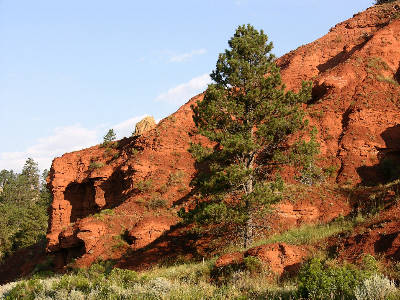
After
a good nights sleep I again roamed around the monument for awhile
before heading out for the next stop on my adventure.
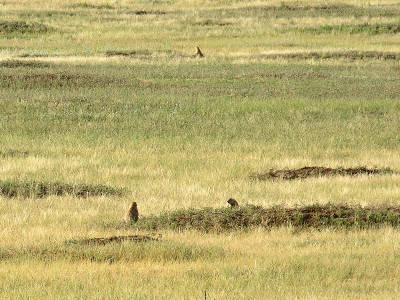
At
Devil's Tower is a Prairie Dog town, that is being impacted by
people trampling over the area and feeding the Prairie dogs.
I got some nice photographs of deer while waiting for
sunset. The website
reports : "In
the spring of 2004, visitors reported a black bear sighting every
2.5 days while mountain lion sightings averaged 1 every 3.6
days." I
manages to get some nice photos in the morning sun with it shining
on the opposite side of the tower from the night before.
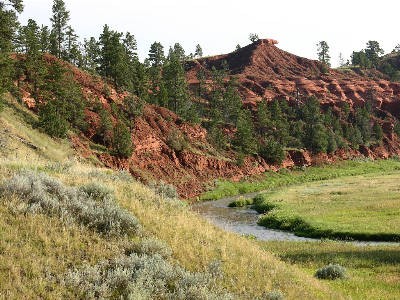
Belle Fouche
River
Sacred
Place
I
am providing the information below as limited excerpts from an
article on the NPS website on the cultural aspects of the tower to
Native Americans. http://www.nps.gov/archive/deto/place.htm
How
is Devils Tower A Sacred Site to American Indians?
By George L. San Miguel, August 1994
"A
review of the ethnographic literature demonstrates that Devils
Tower was a sacred area for several Plains Tribes, and that it has
been encoded as an important landmark in tribal narratives."
According to the National Park Service, over twenty tribes
have potential cultural affiliation with Devils Tower National
Monument.
Cheyenne
The
Cheyenne call Devils Tower "Bear's Lodge," "Bear's
House," "Bear's Tipi," and "Bear Peak."
"A band of Cheyenne Indians went on one of its visits
to 'Bear's Tipi' to worship the Great Spirit, as did many other
tribes before the white man came. The Cheyenne braves took their
families with them as they felt that would be safe, as Bear's Tipi
was a holy place." Devils
Tower is where Sweet Medicine died and it is his final earthly
resting place. Sweet Medicine is the great culture hero of the
Cheyenne who brought the Four Sacred Arrows to the tribe. The Four
Sacred Arrows' sanctuary was located within a secret cave on the
south side of Bear's Lodge. Sweet
Medicine also founded the Cheyenne Warrior Societies, tribal
government, special laws, and ceremonies. As Sweet Medicine lay
dying in a hut by Bear's Lodge, he foretold a dark prophecy of the
coming of the horse; the disappearance of the old ways and the
buffalo, to be replaced by slick animals with split hoofs the
people must learn to eat (cattle). He told of the coming of white
men, strangers called Earth Men who could fly above the earth,
take thunder from light, and dig up the earth and drain it until
it was dead.
Lakota
(Sioux)
The
Lakota call Devils Tower "Bear Lodge," "Bear Lodge
Butte," "Grizzly Bear's Lodge," "Penis
Mountain," "Mythic-owl Mountain," "Grey Horn
Butte," and "Ghost Mountain." The Lakota people
have a sacred narrative or legend on the origin of Bear Lodge. The
Lakota often had winter camps at Devils Tower. 2 This is
documented at least as far back as around 1816. The Lakota claim
to have an ancient and sacred relationship with the Black Hills of
South Dakota and with Devils Tower and Inyan Kara in the Black
Hills of Wyoming. The Black Hills are the Lakota's place of
creation. A Sioux
legend tells of a Lakota band camped in the forest at the foot of
Bear Lodge. They were attacked by a band of Crow. With the
supernatural assistance of a huge bear, the Lakota were able to
defeat the Crow.
At
Devils Tower, they fasted, prayed, left offerings, worshipped the
"Great Mystery" (the essence of Lakota spiritual and
religious life), and performed sweatlodge ceremonies. Lakota pray
for health, welfare, and personal direction.
The healing ceremony is known to have been performed at
Bear Lodge, conducted by a healing shaman. The Great Bear Hu Nump
imparted the sacred language and ceremonies of healing to Lakota
shamans at Bear Lodge. In this way, Devils Tower is considered the
birthplace of wisdom.
"White
Bull told of 'honor men' among the people who went up close to
Devils Tower for four-day periods, fasting and praying. There they
slept on beds of sagebrush, taking no food or water during this
time. Once, five great Sioux leaders-Sitting Bull, Crazy Horse,
Red Cloud, Gall, and Spotted Tail-went there together to worship.
We did not worship the butte, but worshipped our God."
Vision
quests are a very intense form of prayer requiring much
preparation, fasting, sweating (sweatlodge), and solitude 1. It is
a ritual integral to the construction of Lakota identity. In
addition to learning lore and moral teachings, individuals who
seek visions, "often regain clarity of purpose in their lives
and a secure identity as a member of their tribe." Men and
women may seek a vision for a variety of reasons: to give thanks,
to ask for spiritual guidance, or simply to pray in solitude. 3
One of Devils Tower National Monument's archeological sites,
assessed by archeologist Bruce Jones in 1991, is a post-1930's
shelter made of stone and wood which could have been used for
vision quests.
The
Lakota traditionally held their sacred Sun Dance at Devils Tower
around the summer solstice. The Belle Fourche River was known to
the Lakota as the Sun Dance River. Bear Lodge is considered a
sacred place of renewal. The Sun Dance is a group ceremony of
fasting and sacrifice that leads to the renewal of the individual
and the group as a whole. The Sun Dance takes away the pain of the
universe or damage to Nature. The participant suffers so that
Nature stops suffering. The Sun Dance is "...the supreme rite
of intensification for the society as a whole..." and
"...a declaration of individual bravery and
fortitude..." "Young men went through the Sun Dance
annually to demonstrate their bravery as though they themselves
had been captured and tortured, finally struggling to obtain their
freedom."3 The tearing of the pierced flesh is symbolic of
obtaining freedom and renewal. NPS records indicate that modern
Sun Dance ceremonies have been held at Devils Tower since 1983.
The
Lakota also received the White Buffalo Calf Pipe, the most sacred
object of the Lakota people, at Bear Lodge by White Buffalo Calf
Woman, a legendary spiritual being. The sacred pipe's sanctuary
was located within a secret cave on the north side of Bear Lodge.
1 In 1875, General George A. Custer swore by the pipe that he
would not fight Indians again. "He who swears by the pipe and
breaks oaths, comes to destruction, and his whole family dies, or
sickness comes upon them." Pipes often are held as sacred
objects used in vision quests, Sun Dances, sweatlodge rites, and
in making peace.
First
Stories
In
the 1930's, the importance of Devils Tower to many Plains Indians
was recorded in first person narratives.
Devil's Tower First Stories:
http://www.nps.gov/archive/deto/stories.htm
This page provides a written copy of many of these
narratives.

Climbing
of the Tower
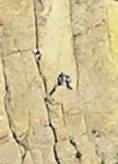
After
returning home and looking at my images, I discovered that I had
by chance taken a photo that showed a pair of climbers on the face
of the rock. Accounts
of early climbs are presented on the park website:
http://www.nps.gov/archive/deto/first_climb.htm
The
first climb was made July 4, 1893, when William Rogers a cowboy
living near Devils Tower made the ascent. This ascent was made via
a ladder which was constructed a short time prior to the climb.
Rogers and his neighbor W. L. Ripley, had spent days constructing
the ladder, carrying the small stakes up the Tower and pounding
them in. Two-by-fours were nailed to the stakes, thus making a
crude device which has ever since been called "the
ladder."
The
First Technical Climb
Devils
Tower, until Monday, June 28, 1937, unclimbed save by use of rope
and stake ladder, has been conquered. Fritz Wiessner, New York,
Lawrence Coveney, New York and William P. House, Pittsburgh,
Penn., all members of the American Alpine Club, New York City,
made the ascent up the almost perpendicular columned laccolith in
slightly less than five hours.
The
party of climbers arrived at Monument headquarters in the late
afternoon of the previous day and spent some time in a
reconnaissance of the south side of the Tower and the completion
of plans for the ascent. At 6:30 the following morning the climb
began, after making their way up over 200 feet of rough talus to a
point where the columns rise almost perpendicular. They reached
the top 600 feet higher at 11:18, four hours and 48 minutes from
the time they began the ascent; 30 minutes was spent exploring the
top, collecting requested specimens of the flora as well as
samples of the rock found at the summit, taking pictures, and
noting in detail points of scientific interest. One hour and
forty-two minutes were consumed in the descent which was
terminated at 1:30, with a total round-trip time of exactly seven
hours. Both ascent and descent were made via the same route on the
south side of the Tower.
Current
Climbs
Today
the climbers are using a combination of free climbs and removable
chocks and nuts that do not damage the rock as they climb.
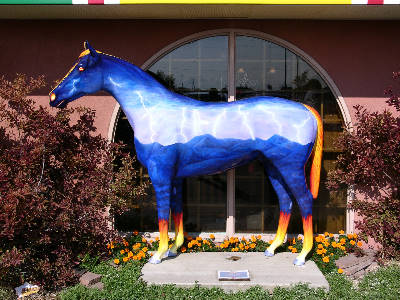
This is an
example of public art located at a Perkin's I stopped at for
lunch after leaving Devil's Tower.